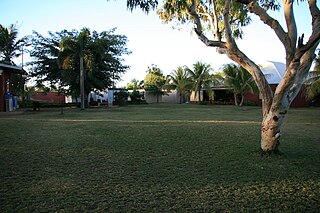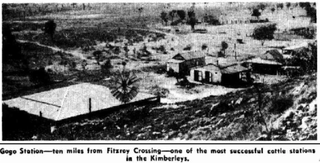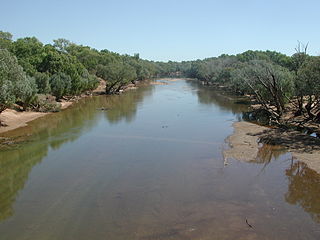




Louisa Downs, [1] also commonly just referred to as "Louisa", is a large cattle station midway between Fitzroy Crossing and Halls Creek in the Kimberley region in Western Australia.





Louisa Downs, [1] also commonly just referred to as "Louisa", is a large cattle station midway between Fitzroy Crossing and Halls Creek in the Kimberley region in Western Australia.
Originally of about 1,000,000 acres (4,000 km2) is size, the station encompasses a significant section of the south eastern end of the Wunaamin-Miliwundi Ranges and the southern boundary is on the northern end of the Great Sandy Desert.
In 1962 when the station was purchased by Karl Stein it was combined with the neighbouring station, Bohemia Downs, now known as Kupartiya, [2] and also nearly 1,000,000 acres in size, and run as one enterprise with approximately 17,000 head of cattle.
The Margaret River enters the station on its eastern boundary near the junction of the Mary River, then running in a north westerly direction between the Lubbock and Kuniandi Ranges and entering the Mueller Ranges at "Me No Savy" in a wide gorge, the site of a potential irrigation dam.
The homestead is located on the banks of the Margaret River near Mount Frank.
A significant meteorite crater (astrobleme) known locally as Goat Paddock Pocket is located in the northern part of the station near the junction of the O'Donnell and Margaret River in an area known as "Bluebush".
The combined station has since been broken up into four stations and the original Louisa Downs has now been returned to its original owners, the Cox family.
The station is notable for its association with the Cox family, who were early settlers in the region. William Cox, aka Billy, died at Louisa in 1944 and is buried in a grave just to the west of the homestead. Billy moved from Noonkanbah Station some time in the 1930s with his young son Fred.
Freddie [3] lived almost his entire life there, died in 1991, and is buried next to his father.

During an influenza epidemic in the Kimberley in 1934, 14 Aboriginal people died from the disease on Louisa, out of the 129 fatalities overall. [4]
Leslie Arthur Schubert, [5] who purchased Louisa Downs along with the neighbouring Bohemia Downs in December 1966, was one of the pioneers of aerial mustering at Louisa in 1967 using Cessna 182 fixed wing aircraft and much smaller teams of Aboriginal stockmen. [6]
Communications between the aircraft and the stockmen on the ground was very unreliable, using 27 MHz citizens band "walkie talkie" radios. The radios often failed or were broken through rough use by the stockmen while on horseback. Hand written notes on strips of toilet paper were then dropped to the white overseers who accompanied these teams, as the Aboriginal stockmen were largely illiterate.
The development of this method of mustering was very effective and the numbers of wild cattle that were able to be mustered rose dramatically. This enabled the culling of many of the lower quality wild bulls, leading eventually to improved blood lines.
The Bluebush area was originally only accessible by horse or foot along the dry bed of the Margaret River and all supplies for the muster had to be taken in by pack horse. In 1968 Les Schubert surveyed a route through the ranges and along the bed of the Margaret River and constructed a rugged track into the area.
Shortly after, he cleared a 300 metre airstrip near the junction of the Margaret and O'Donnell Rivers at "Junction Yard" using a small front end loader and manual labour. This airstrip enabled station staff and stores to be flown in, in less than 20 minutes from the homestead instead of a gruelling five hour drive in a Land Rover over rough station tracks.
Goat Paddock Pocket was used as a large holding yard for cattle during the annual muster in this area.
The Public Works Department set up a flow monitoring station on the Margaret River at the entrance of the gorge where it enters the Mueller Ranges, in 1966. Debate continues about the use of the Fitzroy as a water source for the south west of Western Australia.
In 2005, Department of Housing and Works received grants totalling A$281,300 to build airstrips and improve facilities to Royal Flying Doctor Service standard at Louisa Downs and other places in the Kimberley as part of the Regional Airports Development Scheme funding provided by the Gallop government. [7]
A helicopter crashed in a gorge near Margaret River at the station boundary in 2012. The sole occupant, the pilot, was killed in the crash when the helicopter struck a rock face then plunged into the water below and was submerged. [8]

In Australia, a station is a large landholding used for producing livestock, predominantly cattle or sheep, that needs an extensive range of grazing land. The owner of a station is called a pastoralist or a grazier, corresponding to the North American term "rancher".

The Gibb River Road is a road in the Kimberley region of Western Australia.

Fitzroy Crossing is a small town in the Kimberley region of Western Australia, 400 kilometres (250 mi) east of Broome and 300 kilometres (190 mi) west of Halls Creek. It is approximately 2,524 kilometres (1,568 mi) from the state capital of Perth. It is 114 metres (374 ft) above sea level and is situated on a low rise surrounded by the vast floodplains of the Fitzroy River and its tributary Margaret River.

In Australia and New Zealand, a cattle station is a large farm, the main activity of which is the rearing of cattle. The owner of a cattle station is called a grazier. The largest cattle station in the world is Anna Creek Station in South Australia, which covers an area of 23,677 square kilometres.

The Fitzroy River, also known as Martuwarra, is located in the West Kimberley region of Western Australia. It has 20 tributaries and its catchment occupies an area of 93,829 square kilometres (36,228 sq mi), within the Canning Basin and the Timor Sea drainage division.

A cattle drive is the process of moving a herd of cattle from one place to another, usually moved and herded by cowboys on horses.

The Margaret River is a river in the Kimberley region of Western Australia.

Pardoo Station is a pastoral lease, formerly a sheep station, and now a cattle station approximately 120 kilometres (75 mi) east of Port Hedland and 121 kilometres (75 mi) north of Marble Bar, in the Pilbara region of Western Australia.

Argyle Downs is a pastoral lease and cattle station located about 120 kilometres (75 mi) south east of Kununurra in the Kimberley region near the border of Western Australia and Northern Territory. It is operated by the Consolidated Pastoral Company.
Landor or Landor Station is a pastoral lease and sheep station located in the Gascoyne region of Western Australia.

Fossil Downs Station is a pastoral lease and cattle station located about 50 kilometres (31 mi) north east of Fitzroy Crossing in the Kimberley region of Western Australia.

Home Valley or Home Valley Station is a pastoral lease and cattle station in Western Australia.

Gogo or Gogo Station and sometimes referred to as Margaret Downs is a pastoral lease that has operated as a cattle station. It is located about 11 kilometres (7 mi) south of Fitzroy Crossing and 83 kilometres (52 mi) north east of Yungngora in the Kimberley region of Western Australia.

Wave Hill Station, most commonly referred to as Wave Hill, is a pastoral lease in the Northern Territory operating as a cattle station. The property is best known as the scene of the Wave Hill walk-off, a strike by Indigenous Australian workers for better pay and conditions, which in turn was an important influence on Aboriginal land rights in Australia.

Yeeda Station is a pastoral lease that operates as a cattle station in the Kimberley region of Western Australia.
Charnley River–Artesian Range Wildlife Sanctuary is a protected area covering about 3,000 square kilometres (1,200 sq mi) in the Kimberley region of Western Australia. It is situated about 205 kilometres (127 mi) east of Derby and 287 kilometres (178 mi) north west of Halls Creek, and is accessed via the Gibb River Road. It is named after the Charnley River that flows through the property.
Kimberley Downs Station, commonly referred to as Kimberley Downs, is a pastoral lease that operates as a cattle station in Western Australia.
Napier Downs Station, commonly referred to as Napier Downs, is a pastoral lease that operates as a cattle station in the Kimberley region in Western Australia.
The Djaru people are an Aboriginal Australian people of the southern Kimberley region of Western Australia.
Leslie Arthur Schubert was a notable Western Australian pastoralist and author born in Eudunda, South Australia on 25 August 1922 and died in Perth on 22 March 2012. In 1974 he was the largest sheep wool grower in West Australia with over 65,000 merino sheep on three sheep stations and two farms totalling over 500,000 hectares of pastoral land.
{{cite web}}: CS1 maint: archived copy as title (link)